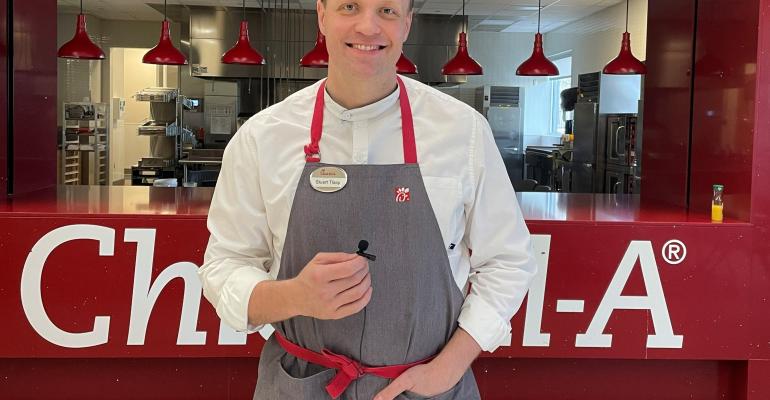Considering Stuart Tracy’s culinary background, it seems a bit serendipitous that Chick-fil-A’s first foray into the plant-based category would feature a cauliflower filet. The chef and former restaurant owner first tried fried cauliflower in 2013.
"It was one of those moments where I wondered why I had never tried it before. How good it was always stayed with me," he said during an interview this week at Chick-fil-A's headquarters in Atlanta. He liked it so much, he added it to his then-restaurant in Charleston, South Carolina.
Chick-fil-A's cauliflower sandwich goes to test on Monday, including in Charleston. The product has gone through about four years of iterations in which Tracy, the chain’s culinary developer, and his team tried dozens of iterations using everything from mushrooms to legumes to beets. Yet, they kept coming back to cauliflower.
The journey of this product dates back to October of 2018, around the same time Tracy joined the Chick-fil-A team. The company was knee-deep in consumer research that clearly illustrated their demand for more vegetables. That consumer research kickstarted the four-plus-year process to get this sandwich into select markets for a test. Yes, that’s an unusually long time for product development, but Chick-fil-A’s process took awhile for several reasons. Covid slowed things down, for starters. Also, the company wanted something differentiated from other plant-based offerings permeating the market at the time.
“Resoundingly, consumers told us they wanted something that tasted like Chick-fil-A, that was identifiable and that was delicious,” Tracy said. “They said they didn’t want it to be mysterious, they didn’t want it to be a scramble of ingredients dressed up like something else. They wanted to see it and say, ‘oh, that’s a mushroom or a green tomato or a cauliflower’ in this case.”
Armed with this data, the team got to work on several such concepts, testing everything from those aforementioned ingredients to legumes to carrots to cauliflower nuggets. There were dozens of iterations.
“We looked at everything from the top to the bottom – every inch of the space. We just kept coming back to the cauliflower sandwich,” Tracy said.
That doesn’t mean it was settled, however. Chick-fil-A had to get its suppliers up to speed, which also took some time.
“We taught our suppliers about how everything is made – the cut, the weight, length, width, how to develop the marinade and then the process of getting it to the restaurants that’s in a state that’s very easy to get to customers and that’s very easy for team members to make it,” Tracy said. “We invented this from the ground up. It’s a differentiator.”
All of these steps are part of Chick-fil-A’s standard food innovation process that includes “understand,” “imagine,” “prototype,” “validate” and “launch.”
The test – which starts Monday and will run through May in the Denver, Charleston, South Carolina, and Greensboro-Triad, North Carolina, markets – is part of the “validate” phase. Whether or not it reaches a systemwide “launch” will depend on a few factors, including whether team members can execute the product with excellence and if customers are willing to purchase the product, according to Leslie Neslage, director of menu and packaging and Chick-fil-A. To support that execution piece, the company went through a “robust” training program last summer at four high-volume restaurants.
“These are restaurants with a lot of customers, a lot of cars, they’re super busy and we threw them in the middle of this and said, ‘OK, make 100 of these sandwiches an hour for six hours.’ We wanted to stress the system to make sure operations could handle this,” Neslage said. “The goal was truly operational. We had great success. We stressed the system, but we did not break the system and that’s what we need to see if we decide this makes sense for us. We cannot disrupt the flow, sacrifice speed or quality.”
Notably, the cooking process mirrors Chick-fil-A’s chicken filet process, which helps keeps things simple in the kitchen. The cauliflower filets are pre-marinated, dipped in an egg and milk wash, then coated once in seasoned coater. They’re then pressure cooked in refined peanut oil. The pressure-cooking process takes a little longer than the chicken, but not enough to affect speed of service, Tracy said.
How the test goes is anyone’s guess at this point. What we know now is that new research from the NPD Group shows that about 20% of consumers want more plant-based options in their diet, while the CDC recently reported that just 10% of Americans eat enough fruits and vegetables, so the potential exists. We also know that feedback from the company’s research panels created throughout the country was positive across the board.
“When we took this specific sandwich and put it in front of customers, we were blown away by the results. It scored so high for taste, value, quality, purchase intent,” Neslage said. “Looking at the customer metrics and ratings, we think this is really special.”
Notably, Chick-fil-A will be intentional about ensuring this sandwich doesn’t cannibalize the “hero” chicken sandwich that has driven so much of the company's growth – and copycats. Rather, the company believes it could drive more occasions and, perhaps, new users.
“This menu item is the perfect complement to our menu for a customer who is looking for the unique and craveable taste of Chick-fil-A, but wants to add more vegetables in their diet,” Neslage said. “This is that menu item.”
Contact Alicia Kelso at [email protected]





